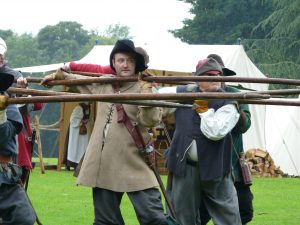The second main arm of the seventeenth century regiment, and often considered the superior arm, was the pike. The pike as a weapon consisted of a 16-18 foot shaft of ash and tipped with a sharp point, the last two foot of shaft would have been protected by languets to stop the point from being cut off.
In addition the pikeman would ideally have been provided with a back and breast plate (to protect his upper body), possibly tassets (which protected the thighs) and a pot (an open faced helmet) to protect the head. The armour would not have been musket ball proof, however it would have offered some protection from stab and thrust wounds. Pikeman would have also been armed with a short sword – a hanger or a tuck.
As with the musketeers the pike would have been formed up in companies, working together as a single unit to utilise their strength. In order to achieve this the pikeman would have to learn a range of drill.
Learn some basic pike drill here
The pike would have fought at the push of pike. The first three ranks would charge their pikes, at the charge, high charge and low charge. The remaining ranks would add their weight to the rear. In close order, shoulder to shoulder, the opposing forces would close on one another. The pikes would interlock and eventually the points would push against the opposing pikeman in a bloody scrum, whereby the stronger side would most often win!
The pike would also be able to protect the vulnerable musketeers from attack by cavalry. Here the pikeman would form a circular formation, they would place the butt of the pike against their right foot and drop the point down. The point would end up at the height of a horses chest and face. As such the horse would refuse to ride home against the pike, no matter how much encouragement the trooper would offer, and the cavalry would be unable to directly attack the foote.
